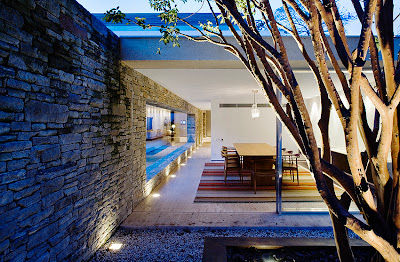This urban house combines dark natural Brazilian hardwood, concrete and vernacular stonework in the open planned style that I love to see. Progressing up the house: stone, concrete framed and then totally wood clad forms are thoughtfully placed.
First up you'll note those fantastic spans and openings. Marcio pushes the boundaries with industrial size spans of pillarless windows all around. Forming the backbone, structurally and visually, of the house is a thick stone clad wall, perforated as well by large spans of glass. This seems to provide a divide between the outside and in, for a house that really opens up to its outside areas.
Entering on the more enclosed side of this wall, guests are no doubt ushered to the open plan living room upon arrival. Passing through the opening in that solid stone backbone they view the pool and deck area, a real summer entertaining spot. Shaded from the heat, guests can relax in this room which seems to be an open area, until you realise Marcio has hidden huge sliding glass doors into the far wall, which seal this area up in winter/at night.
With the lights of the big city in the distance, this house is a secure oasis for the resident family. Downstairs an open relaxed living area, and then through and further down the backbone, a formal dining room served by the kitchen hidden off the corridor with a snack room.
Upstairs, away from the buzz of guests, three children's rooms with en suites, a master bedroom and as all houses should have, two walk in wardrobes. I'm presuming that the smaller, forming a corridor to the first Master en suite, is for the working father. The second, a room larger than the kids bedrooms, I presume is for the lady of the house (my wife was very impressed!), and is separate from the second en suite and bath tub.
Rounding off the floors of the house is the home cinema room on the final floor, encased in that lovely hardwood, with views across to the city, reminding you of the action around, even in such comfortable surroundings.
And if it's all too much, dive into the pool or head across the deck to the sauna in the far right corner of the property.



Marcio Kogan
Born in 1952. Graduated from Mackenzie School of Architecture in 1976. Received an IAB award for the Rubens Sverner Day-Care Center in 1983, and in 1994 an award for the facade for the Larmod Store, organized by the Magazine of the newspaper Folha and CCSP (Creation Club of São Paulo). Realised an exhibit of small-scale models entitled “Architecture and Humor”, a critical view of the architectural and urbanistic problems of the city of São Paulo, which had great repercussions throughout the city. Participated in the IV Architecture Biennial with these projects: UMA Store, Strumpf Residence and the MRA-2 commercial building in 1999. Awarded Architectural Record House 2004 for Du Plessis Residence – Laranjeiras / Paraty / Brazil.
via: Marcio Kogan










Comments
Casa De Marcio Kogan
Casa Mirindiba.
Bom, aqui temos uma casa que me realmente alegra poder lhes apresentar no meu Blog.
Graças ao Marcio Kogan e seu equipe, eu trago-lhes imagens de um de seus projetos residenciais mais recentes.
Eu espero logo logo colocar mais de seus trabalhos e se você estiver em São Paulo tem que quedar no Hotel Fasano (projetado juntamente por Marcio Kogan e Isay Weinfeld).
Nelson Kon é o grande fotógrafo.
Esta casa urbana combina pedras, madeira e concreto estilo de planta aberta que eu amo ver. Começando no térreo a casa consiste de três caixas de: pedra, concreto moldado e madeira nativa, de ordem bem pensada.
A primeira coisa que você anotará será aquelas extensões e aberturas fantásticas. Marcio estende os limites com janelas de tamanhos industriais ao redor de toda a casa.
O enfoque estrutural e visual da casa é uma parede de pedra grossa, perfurada também por extensões grandes de vidro. Isto parece fornecer uma divisão entre a parte externa e interna, para uma casa que é totalmente aberto ao exterior.
Entrando no lado mais fechado desta parede, os convidados com nenhuma dúvida, seriam levado diretamente ao living de planta aberta. Passando por uma abertura na parede de pedra vêem a área da piscina e do terraco, um grande zona de entretenimento no verão. Protegidos do calor, os convidados podem relaxar neste quarto que parece ser uma área totalmente aberta, até que você precebe que Marcio escondeu as enormes portas deslizáveis de vidro na parede, que fecham esta área no inverno ou ao entardecer.
Com as luzes da cidade na distância, esta casa é um oásis seguro pra família. No térreo um living relaxada e aberta, e passando pela parede central, o jantar formal servido pela cozinha escondida fora do corredor junto a um quarto de snack. No primeiro piso afastado dos ruídos dos convidados, estão as três quartos das crianças com suites, o quarto de casal e como todas as casas devem ter, dois quartos guardaroupa. Eu estou presumindo que o menor, dando forma de um corredor ao primeiro suite é do pai. O segundo, um quarto maior do que os quartos dos filhos, eu imagino é para a senhora da casa (minha esposa tem ciumes!), e é separado do segundo suite com banheira. E pra acabar no ultimo andar da casa é o quarto de home cinema, encerrado nessa madeira encantadora, com vistas à cidade, lembrando o dono da ação ao redor, mesmo em sua casa aconchegante.
E se a casa for muito agitada, da um pulo na piscina ou atravessa o terraço ao sauna ( escondido no fundo direito da propriedade).
The only thing right now I don't particularly fancy about this house is that there are just so many different materials - there's the dark hardwood, the light wood of the deck, the large mid-grey stone right next to the tiny pale pebbles...
Having all these colours and textures in one house (especially one right next to the other) is a little too much for me, personally. But I do love hardwood, and the weathered, washed-out grey of the deck floor is beautiful.
Can I ask, is that water area near the dining room (1st photo) part of the pool? It looks a bit more like some sort of water feature than something I'd swim in. If the stone wall extends into the water, that's very unusual and kinda cool.
Great articles, btw - I always look forward to reading this site especially as it's all in english! :D
The dark brown wood is a favoutire with me too. The stone work, particularly the flatter pancake stones are very typical in Brazilian houses.
In photo one, the wall continues down into the water.
Even though it's a bit green, it's a swimming pool on that side of the living room and a reflecting pool on the other.
Nick
Thanks for the comment.
I'll have a chat with Marcio and see if I can write an article on this house too.
Regards,
Nick
-pia-